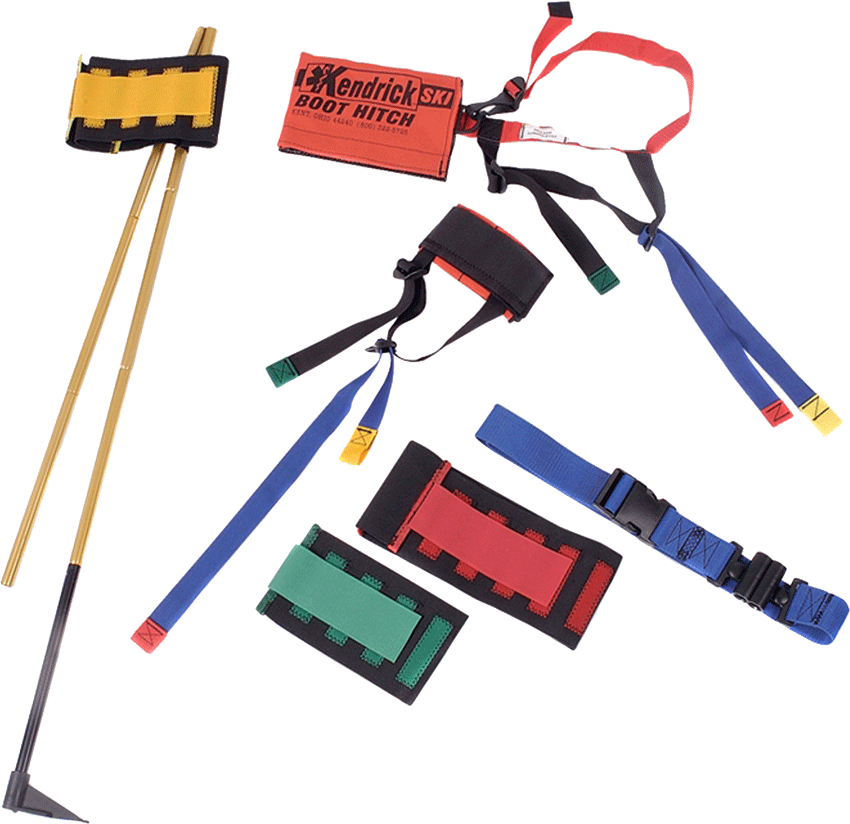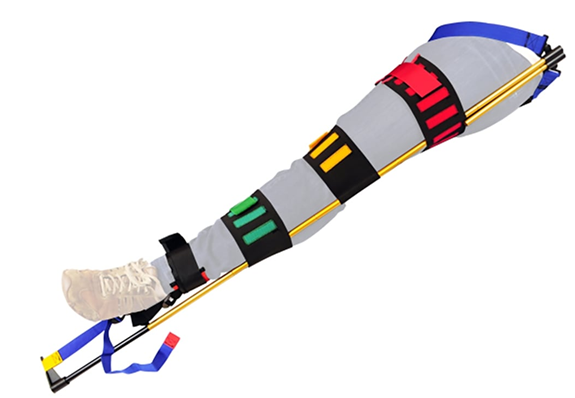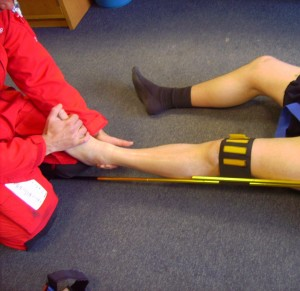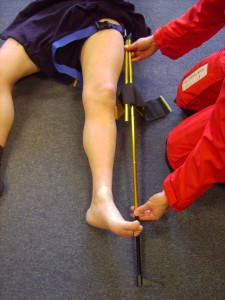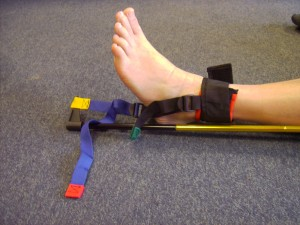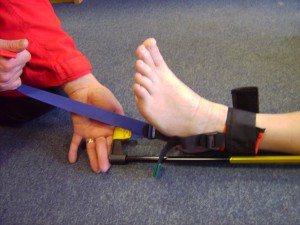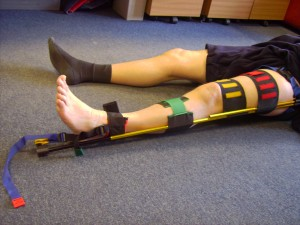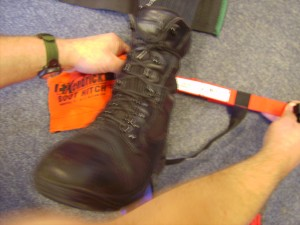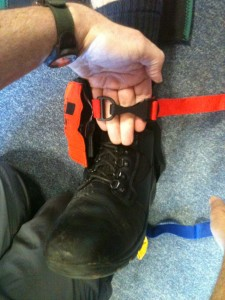
- Immobilise and apply traction to
- Unilateral femoral shaft fractures
- Bilateral femoral shaft fractures
- Femoral fractures in the presence of a confirmed or suspected pelvic fracture
- Ankle or lower limb fractures.
- Significant knee injury.
- Assess distal neurovascular observations:
- Pulse, Colour / Warmth / Movement / Sensation (CWMS)
- Compound fractures may require dressing and wound care.
- Do not apply leg straps over knee as this will cause misalignment and pain.
- Procedure is under the control of the person applying manual traction.
- Once traction is applied manually it should not be released until secured via the Kendrick Traction Device.
- All relevant infection control methods to be utilised.
- Prepare splint[1].
- Explain the procedure to the patient.
- Consider appropriate analgesia.
- Expose the injured leg completely; examine the leg, check for pedal pulses, motor and sensory function.
- Assess injured limbs colour, warmth, movement and sensation.
- NOTE: Manual inline traction of the limb should be undertaken as soon as possible and throughout the Kendrick Traction Device application[3].
- Place upper thigh strap high into groin with the pole holes on the outside of the leg. This strap must sit as high as possible.
- Measure out the length of the pole against the leg[4].
The bottom of the pole should extend approximately one section length below the foot. The pole can be shortened and lengthened, folding in a similar manner to a tent pole. - Prior to the ankle strap being positioned, the yellow Velcro strap can be applied just above the knee. This may need tightening after traction has been applied.
- Apply ankle strap[5]. The padded part of the strap sits behind the ankle. Tighten using the green strap. The yellow strap fits over the pole end (black part) and traction can be applied gently by tightening the red strap. Traction should be applied until the leg is comfortably under traction and in anatomical alignment. Check distal perfusion.
- Whilst pulling the red strap, a small amount of counter traction needs to be applied to the Kendrick Traction Device[6].
- Apply the two other Velcro straps. The red strap at the top of the thigh, the green on the lower leg[7].
- Manual in-line traction can now be released.
- The Kendrick Traction Device comes with the option of a boot hitch which can sit over a walking boot if the decision is made not to remove the shoe. The boot hitch strap is laid under the ankle, the white label on the inside of the strap lying closest to the boot [8].
| Settings | |
|---|---|
| Extended Care: | |
| Colour assist: | |
Document Control
Clinical Resources Website
St John Ambulance Western Australia Ltd (ABN 55 028 468 715) (St John WA) operates ambulance and other pre-hospital clinical services. St John WA’s Clinical Resources, including its Clinical Practice Guidelines (Clinical Resources), are intended for use by credentialed St John WA staff and volunteers when providing clinical care to patients for or on behalf of St John WA, within the St John WA Clinical Governance Framework, and only to the extent of the clinician’s authority to practice.
Other users – Terms of Use
The content of the St John WA Clinical Resources is provided for information purposes only and is not intended to serve as health, medical or treatment advice. Any user of this website agrees to be bound by these Terms of Use in their use of the Clinical Resources.
St John WA does not represent or warrant (whether express, implied, statutory, or otherwise) that the content of the Clinical Resources is accurate, reliable, up-to-date, complete or that the information contained is suitable for your needs or for any particular purpose. You are responsible for assessing whether the information is accurate, reliable, up-to-date, authentic, relevant, or complete and where appropriate, seek independent professional advice.
St John WA expressly prohibits use of these Clinical Resources to guide clinical care of patients by organisations external to St John WA, except where these organisations have been directly engaged by St John WA to provide services. Any use of the Clinical Resources, with St John WA approval, must attribute St John WA as the creator of the Clinical Resources and include the copyright notice and (where reasonably practicable) provide a URL/hyperlink to the St John WA Clinical Resources website.
No permission or licence is granted to reproduce, make commercial use of, adapt, modify or create derivative works from these Clinical Resources. For permissions beyond the scope of these Terms of Use, including a commercial licence, please contact medservices@stjohnambulance.com.au
Where links are provided to resources on external websites, St John WA:
- Gives no assurances about the quality, accuracy or relevance of material on any linked site;
- Accepts no legal responsibility regarding the accuracy and reliability of external material; and
- Does not endorse any material, associated organisation, product or service on other sites.
Your use of any external website is governed by the terms of that website, including any authorisation, requirement or licence for use of the material on that website.
To the maximum extent permitted by law, St John WA excludes liability (including liability in negligence) for any direct, special, indirect, incidental, consequential, punitive, exemplary or other loss, cost, damage or expense arising out of, or in connection with, use or reliance on the Clinical Resources (including without limitation any interference with or damage to a user’s computer, device, software or data occurring in connection with such use).
Cookies
Please read this cookie policy carefully before using Clinical Resources from St John WA.
The cookies used on this site are small and completely anonymous pieces of information and are stored on your computer or mobile device. The data that the cookies contain identify your user preferences (such as your preferred text size, scope / skill level preference and Colour Assist mode, among other user settings) so that they can be recalled the next time that you visit a page within Clinical Resources. These cookies are necessary to offer you the best and most efficient possible experience when accessing and navigating through our website and using its features. These cookies do not collect or send analytical information back to St John WA.
Clinical Resources does integrate with Google Analytics and any cookies associated with this service enable us (and third-party services) to collect aggregated data for statistical purposes on how our visitors use this website. These cookies do not contain personal information such as names and email addresses and are used to help us improve your user experience of the website.
If you want to restrict or block the cookies that are set by our website, you can do so through your browser setting. Alternatively, you can visit www.internetcookies.com, which contains comprehensive information on how to do this on a wide variety of browsers and devices. You will find general information about cookies and details on how to delete cookies from your device. If you have any questions about this policy or our use of cookies, please contact us.
